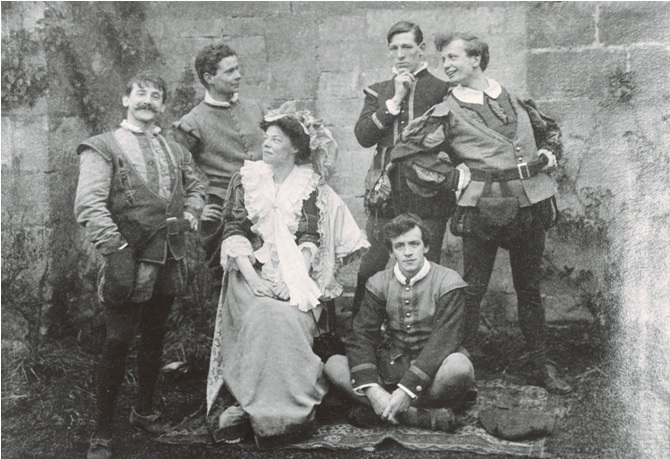
By Olivia Tracey
2022 marks 120 years since C. R. Ashbee and his wife Janet arrived in Chipping Campden with their Guild of Handicraft to start a new life ‘in Arcadia’. Through the reigns of six monarchs, Court Barn is celebrating the changes that have occurred from 1902 to 2022, as well as marking the impact of the Guild on Chipping Campden. But why was theatre so important for introducing the cockney Guildsmen to a community of Cotswold farmers?
‘Farewell! All quality of high renown,
Pride, pomp, and circumstance of glorious town…’
Richard Brinsley Sheridan, The School for Scandal, ‘Epilogue’, by George Colman
After a riot of satire, slapstick and gossip, the character Lady Teazle (the young provincial wife of the older Sir Peter Teazle) makes the final epilogue speech of Sheridan’s play, realising that due to society scandal, she must leave London and return to the country. In January 1904 Ashbee’s Guild of Handicraft staged The School for Scandal, just two years after leaving ‘glorious town’ themselves.

Lady Teazle was played by semi-professional actress Gwendolen Bishop while her husband Sir Peter was played by Ashbee himself. Guild biographer Fiona MacCarthy amusingly notes that to play the role, Ashbee shaved off his ‘moustache and small imperial’ to the dismay of Janet and their friends, who allegedly banished him abroad later that year to regrow his characteristic facial hair.
The School for Scandal was undoubtedly chosen as it juxtaposed London society and rural sensibility. However, it was also an apt play for binding Campden’s two communities together via laughter. This was solidified a year later with the Guild production of one of Shakespeare’s most famous comedies, As You Like It…
‘… there they live like the old Robin Hood of England. They say many young gentlemen flock to his every day and fleet the time carelessly as they did in the golden world.’
William Shakespeare, As You Like It, Act 1 Scene 1

MacCarthy and sports historian Martin Polley note how Ashbee wrote on his programme for their 1905 production of As You Like It that Shakespeare’s comedy was ‘a local play’ about Chipping Campden. The play’s first act includes a wrestling scene which evidently captivated Ashbee and his desire to resurrect the Robert Dover’s Cotswold Olimpick Games: ‘Shakespeare… probably did see [the character] Charles the Wrestler challenge the lads of Campden at the games on Dover’s Hill’.
It’s impossible to know whether Shakespeare actually witnessed the Games, established in 1612, but it’s easy to see how Ashbee would have loved this story, augmenting his belief that Campden at the turn of the twentieth century still represented a ‘Merrie England’ rural Arcadia.
In the play, various nobles escape the strictures of courtly life for the forest where order is upended – the ostracised Duke and his followers become simple forest folk who find ‘tongues in trees, books in the running brooks, sermons in stones and good in everything’ (Act 2, Scene 1, 16-7). Ashbee had notable socialist tendencies and was fascinated by sport, song and performance as communal entertainment, so it’s clear how the plot of As You Like It must have struck a chord.
‘Where be we now, child?’
‘… I cannot tell, unless we be at Mile-End. Is not all the world Mile-End, mother?’
Francis Beaumont, The Knight of the Burning Pestle, Act 2
In January 1906, the Guild revived a play in Campden which they had previously performed in London in 1899: Francis Beaumont’s 1613 city comedy The Knight of the Burning Pestle.
Biographer Alan Crawford observes how Ashbee had a ‘simplified view’ of drama from this time, assuming it was ‘“popular” and unprofessional’. Beaumont’s play was, in fact, performed professionally to a private audience and parodied the more populist apprentice-hero dramas taking place in other playhouses. Nevertheless, a play in which Mile End apprentices win the day would have been the perfect crowd-pleaser for Campden’s cockney residents.
Sadly, the 1906 production also revealed how the Guild had changed since 1899. The metalworker Arthur Cameron had played the original young apprentice hero Rafe in 1899, yet by 1906 had, according to Crawford, ‘grown too portly’ to perform the role, while many of the original cast were either sick or had moved away. Janet Ashbee wrote at the time of the Guild: ‘the gaps yawn so many and so wide’.
‘… I like this place
And willingly could waste my time in it.’
As You Like It, Act 2, Scene 4
Ultimately, theatrical performance was a huge part of Chipping Campden’s calendar. The comedies chosen for these performances would have brought much-needed revelry to both Guild and local communities during the cold Cotswold winters, but they were also symbolic of Ashbee’s own vision of craftsmanship in Campden. The shared experience of performance and playgoing united the community while the plays themselves supported Ashbee’s notion of the Guildsmen continuing in a medieval tradition and that a small Cotswolds market town could really become a new Arcadia.
Bibliography and Further Reading
MacCarthy, Fiona, The Simple Life: C. R. Ashbee in the Cotswolds (London: Faber and Faber, 2014)
Polley, Martin, ‘“A Fine Solidarity in the Life of the Countryside”: The Ashbees and Sport in the Cotswolds, 1902-1907’, The International Journal of the History of Sport, 38 (2021), 1520-1538
Crawford, Alan, C. R. Ashbee: Architect, Designer, and Romantic Socialist (Yale: Yale University Press, 2005)
+44 (0)1386 841951
admin@courtbarn.org.uk



October – March
Tuesday – Sunday 10am – 4pm
April – September
Tuesday – Sunday 10am – 5pm